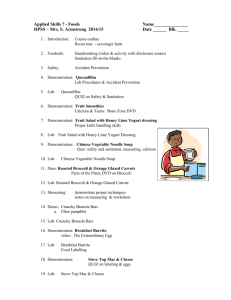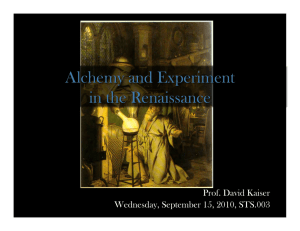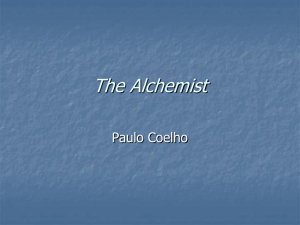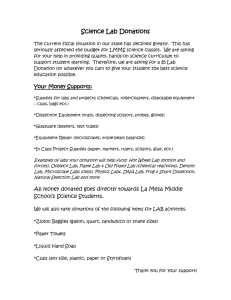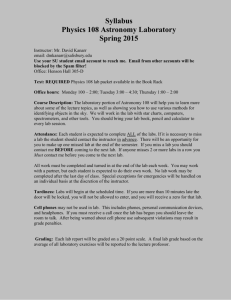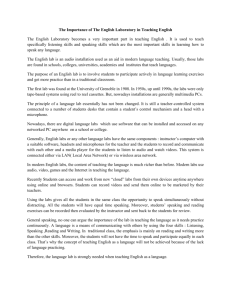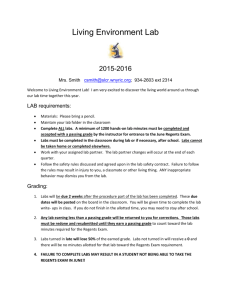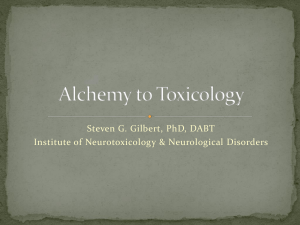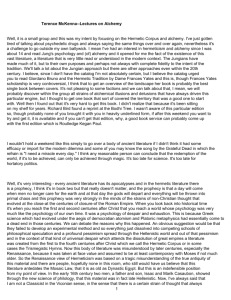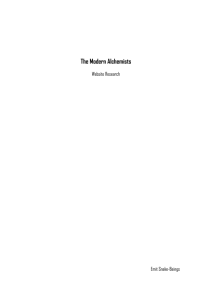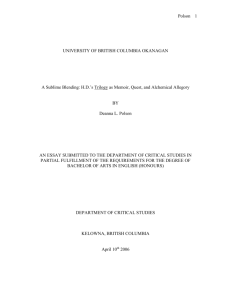The Development of the Laboratory
advertisement
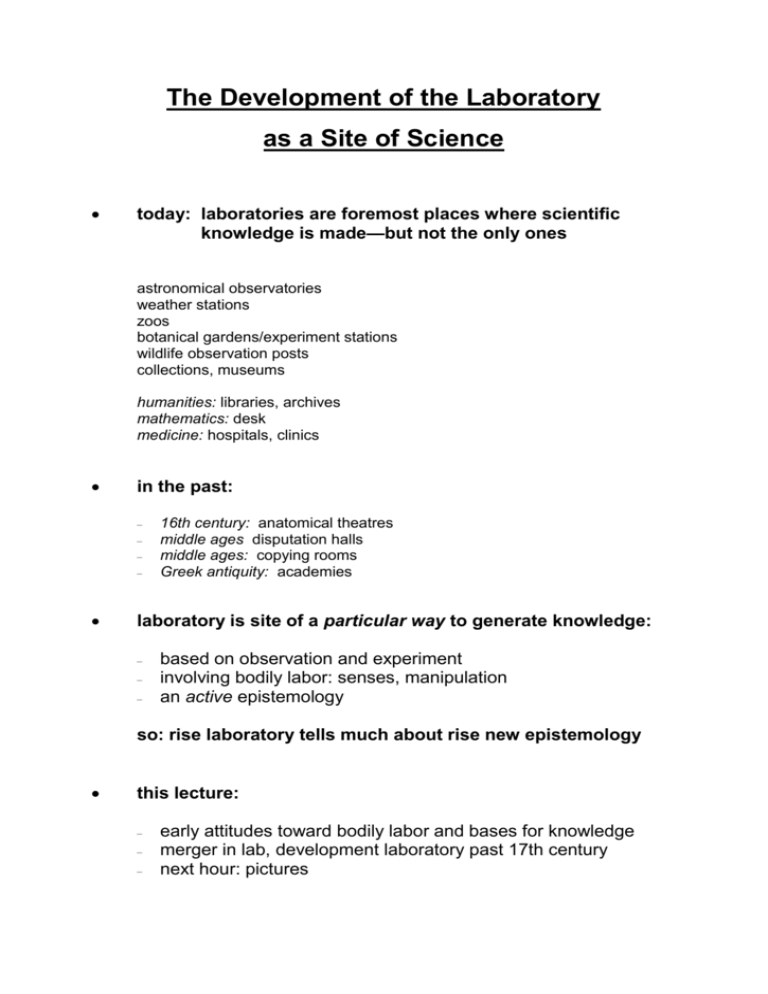
The Development of the Laboratory as a Site of Science today: laboratories are foremost places where scientific knowledge is made—but not the only ones astronomical observatories weather stations zoos botanical gardens/experiment stations wildlife observation posts collections, museums humanities: libraries, archives mathematics: desk medicine: hospitals, clinics in the past: – – – – 16th century: anatomical theatres middle ages disputation halls middle ages: copying rooms Greek antiquity: academies laboratory is site of a particular way to generate knowledge: – – – based on observation and experiment involving bodily labor: senses, manipulation an active epistemology so: rise laboratory tells much about rise new epistemology this lecture: – – – early attitudes toward bodily labor and bases for knowledge merger in lab, development laboratory past 17th century next hour: pictures 1 Ancient Greece manual labor delegated to slaves (not disinterested, leisurely) Plato: only reason provides real knowledge, not senses Aristotle: observation is reliable, experiment is not (technè) 2 Roman Culture no lofty philosophy but an active (political) life in service of the republic 3 Early Christianity and Monastic Movements ambivalent stance toward manual labor: partly penitential: punishment for humans after the Fall partly redemptive: work could lead to salvation monasteries as ‘workshops of the soul’: places to pray and work (ora et labora), containing ‘scriptoria’, ‘oratoria’, ‘dormitoria’, ‘lectoria’, and… ‘laboratoria’ for preparation of medicaments 4 Arabic Scholarship translated and transported ancient Greek philosophy cultivated arts and crafts, e.g. medicine and mathematics merger in alchemy: both straightforward and esoteric both books and handwork: textual and manual tradition (art & nature: Aristotle (imitate), alchemists (equal), new philosophy (master)) 5 Renaissance Humanist reform of knowledge: no contemplation but vita activa scholars should study artisans’ practice Rise of artisan-artists (Da Vinci, Dürer) Result: intensified contact between learned world and practice (scholarship and craftsmanship) Princely courts provide new places for both: search for patronage leads to publication of expertise (book + hand) Humanist return to sources includes the ultimate prisca sapientia: the Book of Nature 6 Paracelsian Movement Paracelsus (1493-1541) launched religious and social reform through the laboratory knowledge of God through His creation—by observation, imitation, and intense experience, spiritually elevating alchemy as model: generative processes as micro-imitations of Creation refinement processes as redemption after the Fall ‘ennoblement’ of both metals and alchemist influence on medicine, religious radicals, German courts (e.g. Rudolph II), and even university (lab course in Marburg, 1609) (laboratories at the center of epistemological, religious, and social reform) 7 The ‘new’ Natural Philosophy of the 17th century embedded in new Academies: often at courts (AdC, RS, ARS) new characteristics: less religiously inclined than Paracelsus, but still inspired on ideals like Francis Bacon’s: a new society build around the laboratory (New Atlantis) not focussed on individual experience but on public knowledge: publication, replication, witnessing establishing ‘matters of fact’ private investigation precedes public demonstration— uneasy separation 8 Laboratory Practice at Leiden University a university to train Dutch citizens to serve their new Republic practical training included in founding statutes (1575) realized later: 1590s: botanical garden and anatomy theatre 1636: clinical teaching (bedside medicine) 1669: chemical laboratory 1674: physical laboratory Leiden becomes model for Halle, Göttingen, Edinburgh, etc. (by now: lab established as prime site of science, but its nature, function and underlying ideology continue to develop through the 18th and 19th centuries) 9 18th century: Demonstration Laboratory in academies: members demonstrated findings in meetings (public/private tension) in learned societies (e.g. Felix Meritis): demonstrations of God’s design (anatomy), wonders of nature (electricity), spectacular effects—popular attractions for elite and masses in universities: demonstrations of phenomena, but also principles—e.g. Newton’s laws of motion, initially merely postulated but now experimentally demonstrated 10 early 19th century: Teaching Laboratory starting with Justus Liebig (1803-1873) who founded a pharmacy school in Giessen centered around chemical analysis students were required to undertake piece of original research and publish results fit well into new German university ideal of Forschung und Lehre enormous school, model for other fields (physiology, physics), model for other nations (Britain, US, Netherlands) 11 late 19th century: Research Laboratory laboratory practice not for training, but for its results research labs outside the academic world: agricultural experiment stations industrial labs inspection labs 20th century: laboratories have become the sites of science and take a central and influential place in society Slide and Sheet Show Early picture 1.@ from: Narrenschip (1497) - oven: the central instrument of the chemical, alchemical laboratory until the 19th century. - balance: emblem of precision and reliable judgment, atypical of alchemy, more common in assayers' lab. - no books: unusual, for books were tokens of scholarship and much affiliated with the alchemical tradition Same picture 2.@ from: The Antichrist and the Fifteen Signs (1460) previous picture was derived from this one showing its real meaning and context: - identical scene, but with a devil above the head of the man in the middle—this is the antichrist! - the scene is an illustration from a sort of biography of the antichrist (very popular literature); it shows how he was trained, at a certain point in his life, to make gold and to perform other kinds of magic and evil tricks (see text) - so: the picture cannot be read as a ‘photograph' of a laboratory, but it does demonstrate how alchemical labs were associated not only with science and crafts, but with black magic as well—at least in the 15th century recurrent interpretation problem: images carry hidden messages more positive image of alchemist: a busy gentleman 11.@ Stradanus, Distillatio (ca. 1550) - heroic picture of a ‘good' (at least competent) alchemist with many helpers and lots of equipment, note the combination of books and handcraft another picture of laboratory work as useful 8.@ from: J. Wonnecke, Kreuterbuch (1550) - pharmaceutical extraction: 3 phases: selection of branches, distillation, storage - drugs are made by distilling the subtle spirit or the active principle from the bulk of raw, inert material (chemistry as "Scheidekunst" or "scheikunde") extraction not only useful, but strong religious connotations 14.@ Jan Luyken, De Scheider (mid-17th century?) - very interesting emblem—the text reads: The Separator - Who decomposes (you), is your friend The raw being in the test [crucible] Gives its spirit or its best Thus seeks wisdom, through suffering, according to love's property and wish, the spiritual being of man, to detach from the raw parts toward Him - in other words, an allegory is made between the separation of the essential spirits from the raw material through the action of fire in the distillation process and the detachment of man's spirit (his higher part) from his body toward God through suffering - conclusion: in the alchemical laboratory, arts had both a practical and a spiritual/religious significance, the alchemist became ‘transmuted' too religious dimension would disappear there was another aspect of (alchemical) laboratory work that was crucially criticized 4.@ David Teniers, Alchemical Laboratory (mid 17th century) - note how the alchemist is separated from social life, a lone searcher for the truth: solitude had been seen as the ideal condition for profound insights at least since antiquity - this image sat uneasy with the new ideal of public knowledge: truth being depended on public demonstration, testimony (witnessing), and replication—openness the German humanist Libavius criticized secrecy and seclusion and proposed this lab 29. Libavius' "Chemical House" (1606) - this is a design, never realized, but drafted with strong and very specific intentions - the house is meant as an alternative both to secluded alchemical labs (typically located in basements) and to scholarly isolation: it is a city-house that contains labs but also rooms for the chemist and his family - it is a humanist laboratory, reflecting the ideals of: - the vita activa as opposed to the vita contempliva - civil service as opposed to learned isolation 30. floor plan of ibid. but despite the criticism, partly through alchemy (and humanism, and rising artisans, etc.) bodily labor became respected and a prerequisite for obtaining knowledge and mastery 15.@ from: G. Starkey, Polytechnia ofte Vuurstook-kunde (tr. 1687) - glorifying the alchemists' bodily labor through a biblical text, which means: you will have to earn your food through sweat - implying: the alchemist is not a lazy armchair philosopher, but somebody who earns his knowledge through hard work and here we see how laboratory work and philosophy finally merged 13.@ from: Lemery, Cours de Chimie (1st Dutch tr. 1683, this picture is from 4th ed. 1725) - "The Philosophical Laboratory or of the Chemists' Distillery" - the publisher (pharmacist Ten Hoorn) thought it "appropriate to lead readers to chemistry and philosophy" - natural philosophy and practical arts joined precursor of demonstration laboratory 18.@ French demonstration teaching lab, 1650s, from: Barlet, Vray et Methodique Cours de la phisique resolutive, vulgarement dite Chymie - high rank of medical students is clearly apparent - many preparation devices are being shown—and noted - esp. in the Paris Jardin du Roi a series of chemical/medical courses would start to which hundreds of people (not only students) would flock late example of demonstration lab 25.@ Hare's laboratory at the University of Pennsylvania in Philadelphia (1835) - gigantic demonstration lab famous example that indicates some of the problems with demonstration science 22.@ Laboratory Royal Institution: Michael Faraday at work ca. 1840) - color 23.@ idem. - b&w, shows more - note the teapot and the new instruments: electrical machines, Leyde jar, air-pump, magnet—physical science as we know it - still: the scientist as lone searcher for truth - note the stairway, leading to the public lecture hall where Faraday would demonstrate his findings and turn them into certified, public knowledge - again: the tension between (ideals of) private and public science is apparent, and the conventions adopted to solve the problem were different from ours 24.@ Laboratory Royal Institution - this is the lecture hall - note that it is also called a laboratory—not a lab for original investigations but a demonstration laboratory the epoch-making teaching laboratory 26.@ Liebig's lab in Giessen (1842) - in the 1830s and 40s, Justus von Liebig set up a lab that was going to be highly influential, in and outside Germany and in and outside chemistry - it embodies a new way of learning science: research; based on apothecaries' training, focussed on chemical analysis, and aimed at the production of both capable researchers and certified new knowledge - although the place here looks a bit chaotic (many famous and soon-to-be-famous chemists (Hoffmann, Kékulé) are showing themselves here), it was highly disciplined: - Liebig, as a guild master (or one of his assistants, journeymen), would survey the work being done and check if the students made progress in mastering the art - the set-up of the tables (straight, off the wall) is meant to facilitate supervision lab based on Liebig’s model 27.@ University College London, 1846 this teaching lab shows some of the discipline ideals embedded in these places 28.@ Chemical Laboratory University Leipzig, 1898 - note the orderly set-up here and the possibility of a quick overview—these labs have been compared to the ‘panoptikon' type of buildings (constructions with a central, total viewpoint) that was used to supervise prisoners - students were not only there to do research, but also to develop an attitude of precision, tidiness, and careful judgment—an attitude that was considered valuable outside of science too - teaching labs often went hand in hand with the ideal of Bildung: the preparation of model citizens of a responsible elite—initially through study of the classics, later by learning to master the art of observation and experimentation picture of scientists portrayed as researchers 34. Heroic Researchers (Hoffmann?), late nineteenth-century? 35. Industrial Lab: Machine Factory Krause, early twentieth century? Sheets: changes around 1900 within the research university Org Chem lab (1893): representative state building - state architect - emphasis on style: neo-renaissance (expresses learning and Dutch nationality) - hierarchically organized with respect to status - users dissatisfied, evacuated within 40 years Phys Chem lab (1904): ugly, proto-functionalist building - scientist as architect - emphasis on interior: gadgets, instruments, infrastructure - organized with respect to use: light and air - almost 80 years in use the latter type ~ functionalist movement: post WWII Dutch campus labs
